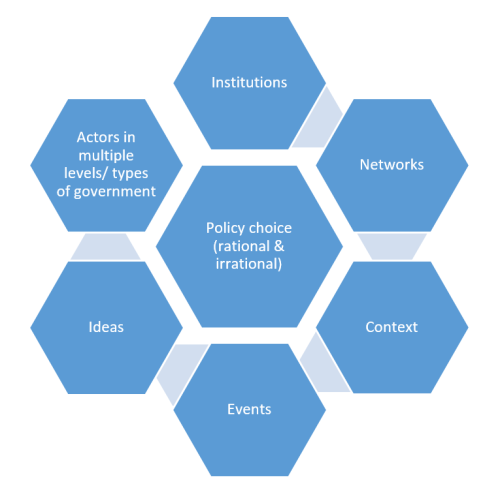We talk a lot about ‘the policy process’ without really saying what it is. If you are new to policy studies, maybe you think that you’ll learn what it is eventually if you read enough material. This would be a mistake! Instead, when you seek a definition of the policy process, you’ll find two common responses.
- Many will seek to define policy or public policy instead of ‘the policy process’.
- Some will describe the policy process as a policy cycle with stages.
Both responses seem inadequate: one avoids giving an answer, and another gives the wrong answer!
However, we can combine elements of each approach to give you just enough of a sense of ‘the policy process’ to continue reading:
- The beauty of the ‘what is policy?’ question is that we don’t give you an answer. I give you a working definition to help raise further questions. Look at the questions we need to ask if we begin with the definition, ‘the sum total of government action, from signals of intent to the final outcomes’.
- The beauty of the policy cycle approach is that it provides a simple way to imagine policy ‘dynamics’, or events and choices producing a sequence of other events and choices. Look at the stages to identify many different tasks within one ‘process’, and to get the sense that policymaking is continuous and often ‘its own cause’.
There are more complicated but better ways of describing policymaking dynamics
This picture is the ‘policy process’ equivalent of my definition of public policy. It captures the main elements of the policy process described (in different ways) by most policy theories. It is there to give you enough of an answer to help you ask the right questions.

In the middle is ‘policy choice’. At the heart of most policy theory is ‘bounded rationality’, which describes (a) the cognitive limits of people, and (b) how they overcome those limits to make decisions. They use ‘rational’ and ‘irrational’ shortcuts to action.
Surrounding choice is what we’ll call the ‘policy environment’, containing: policymakers in many levels and types of government, the ideas or beliefs they share, the rules they follow, the networks they form with influencers, and the ‘structural’ or socioeconomic context in which they operate.
This picture is only the beginning of analysis, raising further questions that will make more sense when you read further, including: should policymaker choice be at the centre of this picture? Why are there arrows (describing the order of choice) in the cycle but not in my picture?
Take home message for students: don’t describe ‘the policy process’ without giving the reader some sense of its meaning. Its definition overlaps with ‘policy’ considerably, but the ‘process’ emphasises modes and dynamics of policymaking, while ‘policy’ emphasises outputs. Then, think about how each policy model or theory tries, in different ways, to capture the key elements of the process. A cycle focuses on ‘stages’ but most theories in this series focus on ‘environments’.








Thank you for sharing this information. It is very useful
Pingback: A general theory of public policy | Paul Cairney: Politics & Public Policy
Pingback: Políticas Públicas en 500 palabras: El proceso de las políticas públicas | Paul Cairney: Politics & Public Policy
Pingback: Policy Analysis in 750 words: Catherine Smith (2016) Writing Public Policy | Paul Cairney: Politics & Public Policy
Pingback: I am not Peter Matthews | Paul Cairney: Politics & Public Policy
Pingback: Chapter 2. Perspectives on Policy and Policymaking | Paul Cairney: Politics & Public Policy